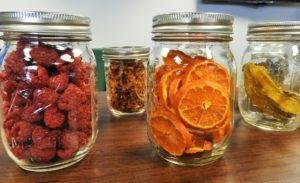Buy extra fruits and vegetables at their peak of ripeness when they are on sale at the grocery store and dehydrate them. The low temperature used in dehydrating vegetables and fruits helps to preserve nutrients. Label your jars with the date and item. Stored correctly dehydrated foods have an extremely long shelf life.
Dehydrating Vegetables
Vegetables you eat raw in salads or soft vegetables such as peppers, celery, tomatoes, mushrooms, zucchini, okra, or onions don’t need to be steamed or blanched before drying. I try to cut these vegetables the same size, so they dry evenly and then spread the vegetables out on the trays in a single layer.
Other vegetables such as corn, peas, potatoes, carrots, broccoli, and green beans will usually rehydrate better if you steam or blanch first then immerse in ice water before drying.
Peel carrots, potatoes, and other root vegetables before slicing and dehydrating because the skins will be tough. The vegetables should be sliced about 1/8″ thick or cut into small pieces. Using a mandolin allows the slices to be a uniform thickness and this helps them dry much quicker.
To blanch your vegetables, first wash them and then boil for 3 minutes. Remove from the heat and dunk into ice water. This slows down the enzyme process, prevents discoloration and food-borne illnesses.
Vegetables should be dehydrated at 125F until crisp. Dehydrating at higher temperatures can cause the vegetables to get a hard crust and not dry properly. If that happens your batch of vegetables are ruined.
This will take anywhere from 4-12+ hours depending on the vegetable, thickness, dehydrator, humidity in your house and the humidity outside. I test them every few hours for crispness after the first 4 hours.
Vegetables To Dehydrate
I save the onion and garlic skins, the carrot peels and tops and potato peels to make bone broth. I just keep a zipper bag in the freezer til broth time.
Onions
Peel and slice the onions into rings ⅛ inch think. Place onions onto dehydrator trays. Arrange them in a single layer and allow for air circulation. Dehydrate for 12 hours. If your dehydrator has a thermostat, set it to 125 degrees until onions are brittle.
Green Peppers
Remove seeds and membranes, then cut into thin strips or cubes. Place peppers on the trays in a single layer allowing air to circulate. Dehydrate for 4–10 hours to become completely dry. Check every couple of hours.
Carrots
Peel the carrots. Cut off the carrot tops. Slice the carrots into 1/2 inch rounds. Remember to blanch first. Fill the dehydrator trays with the carrot rounds. Try to leave a little bit of space between the carrot round, so that air can flow through. Dry the carrots for 6 to 12 hours. Check them at six hours and then every two hours after that. They should be dry, leathery and brittle when they are dehydrated.
Potatoes
Wash and peel the potatoes then blanch. Slice the potato into rounds that are 1/8 inch thick. Lay out the potato rounds on the dehydrator trays. Make sure they are only one layer thick, and they aren’t overlapping. Dehydrate for about 12 hours, or until crisp.
Green Beans
Gently wash fresh green beans and trim off the ends. Blanch in a small amount of boiling water for about 3 minutes. Arrange the green beans on your dehydrator trays, making sure the beans don’t overlap. Dry them for 6-8 hours. Green beans will feel tough and brittle when dried.
Tomatoes
Remove stems and slice ¼ inch thick, or cut cherry tomatoes in half. Place the tomatoes on the tray making sure to leave space between the slices for air circulation. Dehydrate for 5-9 hours.
Zucchini and other squash
Dehydrating can save a bumper crop of summer squash. Trim the tops and bottoms, and slice ⅛ or ¼ inch thick. Place in a single layer so air can circulate. Dehydrate for 7-11 hours.
Bell Peppers
Dried peppers are great for soup mixes. Remove the ribs and seeds and slice ¼ inch thick or chop. Leave space between the peppers for air movement. Dehydrate for 4-8 hours.
How to dehydrate fruit
Apples, bananas, strawberries, or kiwi can be sliced thin, berries are left whole,or the fruit can be pureed and dried into fruit leathers.
Any fruits that will be dried with the skin on need to be washed well because most have a waxy coating on it. Some fruits, like whole blueberries, grapes, and cherries, should be blanched in hot water, followed quickly by an ice bath. This process cracks the skin to promote better dehydration, it’s referred to as checking.
Banana and apple slices need to soak in citrus water for a few minutes to prevent browning. Citrus water is equal parts lemon juice and water. Remove the fruit from the water and pat dry on paper towels.
Fruit should dehydrate in a single layer not touching at 135F. Drying time will vary widely depending on the specific fruit. Apple slices may be done in as little as 6 hours, whereas whole blueberries and cherries could need multiple days.
Fruit is done dehydrating when it becomes leathery and is no longer sticky. Cut a few pieces in half and squeeze them there shouldn’t be any moisture leaking out. If you do see moisture the fruit isn’t done and needs to be put back in the dehydrator.
Cool completely and transfer to airtight containers, such as plastic snap-tops, mason jars or freezer bags. Store in a cool, dark place. After a few days, shake one of the containers. If you notice any moisture, transfer the contents back to the dehydrator for another stint.
Fruits To Dehydrate
Bananas
Peel bananas, slice into ⅛ to ¼ inch thick disks and soak in citrus water for 10 minutes to avoid browning. Dehydrate at 135°F for 6-10 hours.
Apples
Peel and core apples, slice apples into rounds ¼ to ⅜ inch thick, and soak in citrus water for 10 minutes, to avoid browning. Dehydrate at 135°F for 7-15 hours
Strawberries
Sweet dried strawberries go great with granola. Hull strawberries, and slice ¼ to ⅜ inch thick, or cut in half if they’re really little. Dehydrate at 135°F for 7-15 hours.
Mangoes
Peel mango, cut the flesh away from the flat core, and slice ¼ inch thick. Dehydrate at 135°F for 7-15 hours.
Pineapple
Cut off the top and bottom and trim away the tough exterior. Slice the pineapple ¼ to ½ inch thick, removing the core. Dehydrate at 135°F for 10-18 hours.
Having dried fruit on hand gives you lots of choices to add to homemade granola or yogurt.
Dehydrating your fruits and vegetables is more cost efficient than canning, they are light weight and take up less space. I love storing my dehydrated fruits and vegetables in large mason jars or gallon glass jars, this way I can keep an eye on the amounts so I don’t run low.


